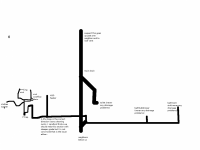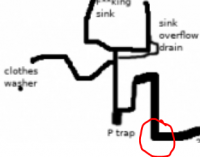mitxi.drain
New Member
we're in a tiny 3rd story apartement building
possibly one toilet and roof vent above us and many toilets and drains below us
see crappy drawing if you want a laugh
kitchen sink has drained slowly since we moved in a year ago
sometimes just slowly (2 minutes) and other times, it takes over 2 hours (this is truely completely random as far as we can tell)
it backs up into our washer too if I have it connected
I'm fairly convinced this is not a clog and it can't be the main vent either since 2 other drains to that main have never had any problems
(please see drawing)
things we've tried:
-plunger (never seems to make any difference
-pipe snake (5 meters) - always came out "clean" and never got stuck on anything other than the pipe bends
-more than a dozen different drain cleaner liquids and gels
-taking apart as many of the pieces of pipe towards the main drain as possible
-I'm planning to get a cheap USB endoscope but I'm not sure it is long enough to be useful
possibly one toilet and roof vent above us and many toilets and drains below us
see crappy drawing if you want a laugh
kitchen sink has drained slowly since we moved in a year ago
sometimes just slowly (2 minutes) and other times, it takes over 2 hours (this is truely completely random as far as we can tell)
it backs up into our washer too if I have it connected
I'm fairly convinced this is not a clog and it can't be the main vent either since 2 other drains to that main have never had any problems
(please see drawing)
things we've tried:
-plunger (never seems to make any difference
-pipe snake (5 meters) - always came out "clean" and never got stuck on anything other than the pipe bends
-more than a dozen different drain cleaner liquids and gels
-taking apart as many of the pieces of pipe towards the main drain as possible
-I'm planning to get a cheap USB endoscope but I'm not sure it is long enough to be useful


